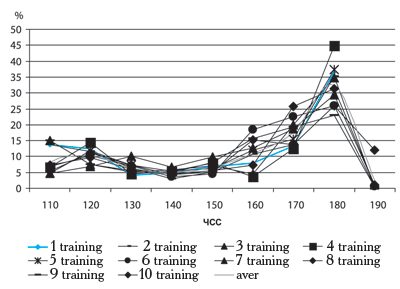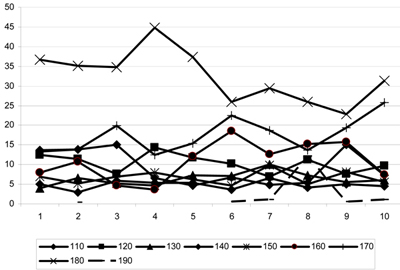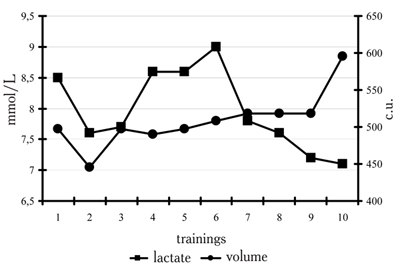Development of Aerobic and Anaerobic Capacity of Judokas via Jumping Training
Фотографии:
ˑ:
S.A. Pelipenko
V.G. Pashintsev, professor, Dr.Hab.
Moscow state academy of veterinary medicine and biotechnology, Moscow
Key words: conditioning, aerobic-anaerobic component, endurance, cardiovascular system, running load, throwing load, intensity, vital capacity, bronchial patency, maximum breathing capacity, pulmonary capacity.
In judo competitive activity takes place mainly in the glycolytic mode of energy supply, which is seen in special working capacity and accordingly in the training process. It is very hard to choose exercises where the load orientation is combined with activity of athletes’ musculoskeletal system. The suggested method of development of special working capacity of judokas corresponds to the glycolytic mode of energy supply and activates the whole muscle system of judokas who demonstrate their technical and tactical skills [1, 2, 4-6].
The purpose of the study was to allocate the influence of jumping training on respiratory and cardiovascular systems of judokas.
Materials and methods. The effect from the jumping load was estimated by analyzing changes in the percentage ratio of heart rate (HR) during the whole training process (Fig. 1). The experiment was carried out in Moscow veterinary academy with 10 judokas of the grade 1 and candidates for master of sport as subjects of the research. HR was measured using the device Polar 650i and the Polar Precision Performance SW software, blood lactate - the device Accutrend Lactate in 5 minutes at the end of a workout. Spirometry was measured using the device Spirobank G (Italy) and a computer Sony PCG-FX 370 with the Winspiro PRO 1.1.7 software.
Results and discussion. Jumping load was determined by analyzing changes of the heart rate percentage ratio during a training process (Fig. 1).

Fig. 1. The dynamics of HR indices during jumping load in the aerobic-anaerobic mode
The graph in Fig. 1 shows a gradual tendency to increase of HR up to 180 bpm, i.e. the main driving exposure (32,4 %) on the body of judokas was at this level of HR, slightly exceeding it (2,6 %) to HR 190 bpm. Thus, under the aerobic-anaerobic jumping load the average minimum HR was 166,6 bpm, the average maximum HR - 172,8 bpm and the average maximum - 182,3 bpm.
During the jumping training cycle HR changed in the following way (Fig. 2). During the training work HR = 110-120 bpm to 160 bpm was approximately 10-11 % of the time, in the range of 130 and 150 bpm - approximately from 5 to 7 %. Starting from 170 bpm the percentage of work performed increased to 17,5 %, at 180 - to 32,4 % and at 190 bpm it droped sharply - to 2,6 %. Thus, it is clear that the heterochromous regime of HR changes increased even more compared with the aerobic training cycle.

Fig. 2. HR percentage ratio in the training cycle
These changes indicate that the body when performing jumping load worked out adaptive mechanisms at a higher level of HR in the aerobic-anaerobic mode.

Fig. 3. Changes in the lactate concentration and volume of work done
Fig. 3 shows the way how the amount of work performed changed and the blood lactate concentration in judokas increased. So, in the 2nd training lactate decreased by 0,9 mmol/L, it can be explained by the adaptation of the body to new workout conditions, as the amount of work done reduced at the same turn. Starting from the third exercise, the blood lactate concentration increases sharply and the volume of work done reduces gradually to the 6th workout, where the lactate concentration first sharply and then gradually starts declining. And the lactate concentration decreased slightly even with a sharp increase in the volume of work done during the 10th training session. Thus, an increase of the threshold of the aerobic-anaerobic performance of judokas can be stated.
The studies revealed the data characterizing changes in athletes’ respiratory system (Table).
The application of the jumping load contributed to slight improvement of the indices of forced vital capacity, bronchial patency and pulmonary capacity from 1,2 to 6,4 %, decrease of expiratory and inspiratory muscle strength by 1,4 and 8,33% and significant (by 19,9 %) increase of maximum breathing capacity.
Table. The dynamics of indices of the respiratory system of judokas after interval running, р<0,05
|
Indices |
|
|
% |
|
FVC, l |
4,26 ±0,21 |
5,25 ±0,32 |
1,23 |
|
Expiratory muscle strength, c.u. |
38,4 ±1,4 |
35,2±1,28 |
-8,33 |
|
Inspiratory muscle strength, c.u. |
36,1 ±2,6 |
35,6±2,9 |
-1,4 |
|
Bronchial patency, c.u. |
7,9±0,35 |
8,3 ±0,54 |
5,1 |
|
PC, % |
133,5±2,71 |
142,1±3,11 |
6,4 |
|
MBC, l/min |
194,6±6,81 |
233,4±5,84 |
19,9 |
Hence, development of the aerobic-anaerobic component of endurance using jumping exercise contributes to an increase of heart rate up to the level of 172 bpm of the average HR along with the increase of blood content of lactate up to 8 mmol/l, resulting in better bronchial patency, pulmonary capacity and maximum breathing capacity of judokas.
References
- Alik, T.A. On the role of aerobic and anaerobic process in the energy supply of muscle work: abstract of Ph.D. thesis; MSU / T.A. Alik. – Moscow, 1963. – 22 P. (In Russian)
- Gabrys’, T. Athletes’ aerobic performance: limiting factors, tests and criteria, means and methods of training: abstract of doctoral thesis (Hab.); RSAPhC / T. Gabrys’. – Moscow, 2000. – 58 P. (In Russian)
- Karazhanov, B.K. The influence of anaerobic exercises on the dynamics of indices of physical working capacity of qualified judokas / B.K. Karzhanov, K.S. Sariev, V.V. Shiyan // Teoriya i praktika fizicheskoy kultury. – 1991. – № 4. – P. 19–20. (In Russian)
- Pashintsev, V.G. The biological model of functional training of judokas / V.G. Pashintsev // Moscow: Sovetsky sport, 2007. – 208 P. (In Russian)
- Pashintsev, V.G. Glycolytic load in training of judokas / V.G. Pashintsev, V.I. Maksimov // Memoir of N.E. Bauman Kazan state academy of veterinary medicine. – Kazan, 2013. – P. 317–221. (In Russian)
- Shiyan, V.V. Special endurance of judokas and the ways of its development: abstract of Ph.D. thesis; SCOLIPhC / V.V. Shiyan. – Moscow, 1983. – 25 P. (In Russian)
Corresponding author: pashincev@mail.ru



